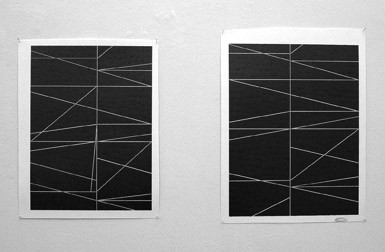Marc Nagtzaam
04 Feb - 02 Apr 2011

© Marc Nagtzaam
Left: Coast to Coast, 2011. Graphite on paper, 46,9 x 36,9 cm, unique
Right: As You Said, 2011. Graphite on paper, 52 x 39,3 cm, unique
Exibition view, ProjecteSD, Barcelona
Left: Coast to Coast, 2011. Graphite on paper, 46,9 x 36,9 cm, unique
Right: As You Said, 2011. Graphite on paper, 52 x 39,3 cm, unique
Exibition view, ProjecteSD, Barcelona
MARC NAGTZAAM
4 February - 2 April, 2011
For Marc Nagtzaam, to draw is to construct an unknown place for the artist and the public to live in: “The drawings,” he says, “are like empty spaces, parallel to the world. I try to create a place that is not clearly defined.”
Nagtzaam works primarily in darkly filled in graphite non-figurative compositions. His visual repertoire ranges from a kind of hard-edge all-over abstraction to the reproduction of the written word. Friezes of lines, dots, circles or meticulously copied text fragments, form the infinite riches of variation in the artist’s work. According to art critic Chris Sharp: “Much of Nagtzaam’s practice could be said to proceed along the same positive/negative lines—a binary that, incidentally, often characterizes his black-and-white palette—in the sense that a step forward is almost always preceded by a step back, or any investiture of the self is invariably countered by a preponderant removal of that same self”.
The idea of the grid is undoubtedly relevant in Nagtzaam’s work. As Dieter Roelstraete pointed out in his essay Twittering Machines (of the Modernist Persuasion): “Marc Nagtzaam’s drawings – for they are always, in the final analysis, drawings, even if their images are made up out of words – are drawn reflections upon the art of drawing itself: thoroughly self-referential and therefore deeply inscribed in the history of modernism (to which occasional reference is made) – made present most palpably in the artist’s exploration of that most hallowed of modernist paradigms, the grid.”
And with the grid, and probably as an inevitable consequence, the notion of the fragment is essential in the way Nagtzaam approaches and processes his works. Copy and repetition are, as well, used by the artist as a ritual and a meaningful element in his work process. The artist deliberately draws the same repeated structures, in different dimensions or compositions, on paper or displaced as wall drawings, over and over, here and there, again, as if he was both mapping and measuring, even indexing small bits of information. Almost the same but yet different. Every drawing appearing only as a tiny part cropped from a much larger fabric. It is maybe because of this that the artist has expressed preference for drawing, because of its quality of incompletion, of its sense of always being unfinished. In Nagtzaam’s artworks, clearly, the content of this preference is expressed not only at the level of the medium, but also on a conceptual and formal level, making such an inclination for incompletion into a strikingly coherent project, where with every drawing a silent intimacy is communicated.
4 February - 2 April, 2011
For Marc Nagtzaam, to draw is to construct an unknown place for the artist and the public to live in: “The drawings,” he says, “are like empty spaces, parallel to the world. I try to create a place that is not clearly defined.”
Nagtzaam works primarily in darkly filled in graphite non-figurative compositions. His visual repertoire ranges from a kind of hard-edge all-over abstraction to the reproduction of the written word. Friezes of lines, dots, circles or meticulously copied text fragments, form the infinite riches of variation in the artist’s work. According to art critic Chris Sharp: “Much of Nagtzaam’s practice could be said to proceed along the same positive/negative lines—a binary that, incidentally, often characterizes his black-and-white palette—in the sense that a step forward is almost always preceded by a step back, or any investiture of the self is invariably countered by a preponderant removal of that same self”.
The idea of the grid is undoubtedly relevant in Nagtzaam’s work. As Dieter Roelstraete pointed out in his essay Twittering Machines (of the Modernist Persuasion): “Marc Nagtzaam’s drawings – for they are always, in the final analysis, drawings, even if their images are made up out of words – are drawn reflections upon the art of drawing itself: thoroughly self-referential and therefore deeply inscribed in the history of modernism (to which occasional reference is made) – made present most palpably in the artist’s exploration of that most hallowed of modernist paradigms, the grid.”
And with the grid, and probably as an inevitable consequence, the notion of the fragment is essential in the way Nagtzaam approaches and processes his works. Copy and repetition are, as well, used by the artist as a ritual and a meaningful element in his work process. The artist deliberately draws the same repeated structures, in different dimensions or compositions, on paper or displaced as wall drawings, over and over, here and there, again, as if he was both mapping and measuring, even indexing small bits of information. Almost the same but yet different. Every drawing appearing only as a tiny part cropped from a much larger fabric. It is maybe because of this that the artist has expressed preference for drawing, because of its quality of incompletion, of its sense of always being unfinished. In Nagtzaam’s artworks, clearly, the content of this preference is expressed not only at the level of the medium, but also on a conceptual and formal level, making such an inclination for incompletion into a strikingly coherent project, where with every drawing a silent intimacy is communicated.
